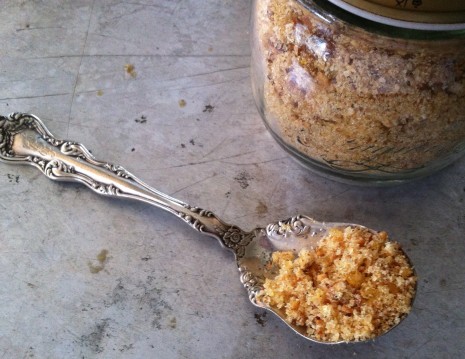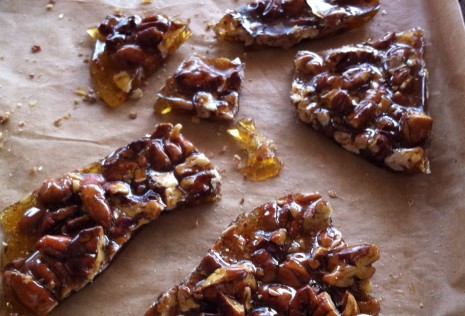IN THE LARDER: PRALINE POWDER
As much as I love the idea of New Orleans pralines (pronounced prah-leens), the creamy, fudgelike patties are far too sweet for me. I’ll take praline powder any day. The pulverized mixture of caramel and nuts is nothing new, but there’s a reason it should have a place in your “quick fix” file. It sends everything from a bowl of ice cream to Sunday morning pancakes or waffles into the stratosphere. It can swing savory as well: Give it a kick with a little cayenne, slather it on some thick-cut bacon (just you wait), and serve it for brunch or even a drinks party, à la Rick Ellis.
In restaurant kitchens, you’ll generally see praline powder made with almonds or hazelnuts. Personally, I’m partial to pecans: Their suave butteriness plays well with the faintly bitter edge of a deep golden caramel. And if making caramel—basically, sugar cooked until just shy of its burning point—intimidates you in the least, think of praline powder as a set of training wheels.
Although there are countless caramel recipes in the world, they can be divided into two types: wet and dry. A wet caramel consists of sugar and water heated together. A dry caramel is nothing more than melted sugar; there is no liquid added. The simple and virtually foolproof recipe below is a hybrid; I learned it from my husband, Sam, who snapped into cooking-school-instructor mode as soon as he saw what I was up to. “Pour just a little water in the pan before adding the sugar,” he said. “It’ll help the sugar cook more evenly.”
Even though this recipe is a cinch, a few caveats are in order:
• You are dealing with boiling syrup. It’s fiendishly hot, so Attention Must Be Paid.
• Avoid making a hard caramel on a humid day; otherwise, it will be sticky and impossible to grind.
• Although you need a heavy pot that conducts heat evenly, avoid one that’s too muscle-bound because you want it to cool down quickly. I use an (ancient) 1½-quart aluminum Revere Ware pot with a copper bottom.
• When cooking the caramel, be patient and let it develop a rich amber color. If it’s too blond, you won’t get the deep flavor you’re after. The finished praline will also tend to suck humidity out of the air and be sticky instead of hard as glass.
Praline powder works as an embellishment year round. Stir it into a crumbly topping for a fruit crisp, sprinkle it on sugar cookies or a plum tart toward the end of baking. Add luster to a weeknight compote of stewed fruit or dinner party–worthy crème brûlée. In moments of stress, a spoonful right out of the jar is remarkably soothing.
Oh! I almost forgot. About that bacon: Cook it on a rimmed sheet pan in a 400º F oven until it starts to turn golden. Meanwhile, stir together praline powder and a smidgen of cayenne pepper or ground cumin. Generously sprinkle the bacon with the praline mixture, then continue to cook until it’s just the way you like it.
Praline Powder
Makes about 2 cups
¼ cup water
1 cup sugar
1 cup pecans, lightly toasted, cooled completely, and roughly chopped
1. Put a piece of parchment paper on a rimmed baking sheet and lightly butter the paper. Pour the water into a small, heavy-bottomed pot. Add the sugar carefully, so that it doesn’t splash up the side of the pot (if that happens, simply wash down the side with a wet brush), and heat over moderate heat until the sugar dissolves. Do not stir. You want the syrup that results to boil and bubble evenly, so make sure the pot is centered on the burner and reduce the heat slightly if the syrup starts to spatter. Take a second to notice what that vigorous boil sounds like: the high-pitched snap-crackle-and-pop of Rice Krispies.
2. Keeping a close eye on the syrup, let it boil undisturbed until it turns a rich golden and smells like cotton candy, about 10 minutes. Listen—it will have quietened down as well.
3. Turn off the heat. Swirl the pan to even out the color (it should look like well-brewed tea) and add the nuts. Working quickly, stir the nuts to thoroughly coat them (a silicone “high heat” spatula is the best tool for the job), then immediately pour the mixture onto the baking sheet. Spread it into a thin layer as best you can, then let the praline cool completely.
3. Break the praline up into smallish shards. Working in a couple of batches, grind the praline into a relatively fine powder in a blender or food processor. Because I’m always surprised at how much praline powder I’ve made (it fluffs up when ground), I usually divide it between 2 small airtight containers. One sits in the cupboard until it’s all used up; the other goes into the freezer. You never know when it will come in handy.
Posted: May 15th, 2012 under cooking, pantry, recipes.
Comments
Comment from Cindy
Time March 21, 2015 at 2:03 pm
Thank YOU! Perfect instructions down to the sound of the sugar cooking. I had no problems whatsoever and now I have the unfortunate problem of what to do with a batch of the most tastiest stuff EVER! Wonderful. I can’t say enough about it and I can’t wait until I have an excuse to make it again and try different nuts. Great recipe.
Comment from admin
Time March 22, 2015 at 2:12 pm
Thanks, Cindy! You made me realize that it’s high time I made another batch….
Cheers,
Jane




Comment from Deb
Time May 19, 2012 at 8:19 am
Praline powder? Oh my goodness! I already have several ideas for using scoops of this marvelous crunchy, sweetness. A delightful post!